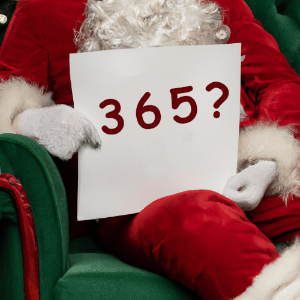How Many Days
In A Year?
How many days are there in a year?
When are there a different number of days in a year?
Find out if it is 365, 366 (or 385!) days
With Santa's Official Christmas 2025
Countdown Clock!

How Many Days In 2025?
⌚ For the year 2025, there are 365 days in the year! ⌚
But keep reading! Tickles the Time-Tracking elf is going to use a little elf magic, poetry and science to help unravel the mysteries of time for you!
Find the Days In A Year (An elf poem)
How many days in a year, you say?
Let me tell you in my Tickles the Elf way!
There's three hundred sixty-five,
That's how many days we keep alive.
But wait, there's even more to know,
Every four years, a leap year will show!
An extra day we get to play,
To laugh and sing and shout "hooray!"
But don't forget the exception, oh dear,
Every hundred years, no leap year I fear.
Unless it's divisible by four hundred, you see,
Then another leap year it shall be.
So, there you have it, my dear friends,
The number of days that a year extends.
Three hundred sixty-five or -six, you know,
Depending on how the numbers go!
How Many Days In Any Year? (How it works)
 🎄 When children all over the world rely on you to deliver presents on one special night each year, you have to make sure you show up on the right night!
That is why I, Tickles the Time-tracking elf, keep tabs on time for Santa!
🎄 When children all over the world rely on you to deliver presents on one special night each year, you have to make sure you show up on the right night!
That is why I, Tickles the Time-tracking elf, keep tabs on time for Santa!
Did you know MOST years have 365 days in them... but not all years have 365 days?
So what exactly is the answer to that timeless question, "How many days are in a year?". Well, sit back and relax as I, one of Santa's trusty helpers, spill the beans on this magical mystery with some crazy calculations.
First things first, let's talk about a regular year. A regular year has 365 days. That's 365 days of cookie-baking, toy-making, and reindeer-training fun.
But wait, there's more!
Every four years, there is a leap year. This means we get an extra day to celebrate the joy and wonder of the holiday season. Hooray!
Now, you may be wondering, how do we know when it's a leap year?
It's simple (well, for us elves, at least 😉).
If you can evenly divide a year by 4, it's a leap year!
But hold on to your candy canes... there are exceptions to this rule!
If you can divide a year by 100, it's NOT a leap year...
Unless you can also divide it by 400! Are you still with me?
So let me break it down.
The year 2000 was a leap year because you can divide it by 4 and 400!
But, the year 1900 wasn't a leap year... because it's divisible by 100, but NOT by 400. See? Easy-peasy.
Now, I know what you're thinking. "You silly elf, why do we even have leap years? What's the point?"
Well, my dear friends, without leap years, our calendars would slowly but surely get out of sync with the seasons. Could you imagine celebrating Christmas in the middle of summer? Yikes!
So there you have it. The answer to the age-old question of how many days there are in a year: It depends on the year!
But at least now you know how to calculate the number of days in a year.
I hope you've enjoyed this little lesson from one of Santa's elves.
And remember, always keep the magic of the holiday season in your hearts...
no matter what day of the year it is!
Days In The Year (A Years and Days List)
⌚ There are 365 days in the year 2025! ⌚
There are 365 days in the year 2010.
There are 365 days in the year 2011.
The year 2012 has 366 days. (2012 is a Leap Year!)
There are 365 days in the year 2013.
There are 365 days in the year 2014.
There are 365 days in the year 2015.
The year 2016 has 366 days. (2016 is a Leap Year!)
There are 365 days in the year 2017.
There are 365 days in the year 2018.
There are 365 days in the year 2019.
The year 2020 has 366 days. (2020 is a Leap Year!)
There are 365 days in the year 2021.
There are 365 days in the year 2022.
There are 365 days in the year 2023.
The year 2024 has 366 days. (2024 is a Leap Year!)
There are 365 days in the year 2025.
There are 365 days in the year 2026.
There are 365 days in the year 2027.
The year 2028 has 366 days. (2028 is a Leap Year!)
There are 365 days in the year 2029.
There are 365 days in the year 2030.
There are 365 days in the year 2031.
The year 2032 has 366 days. (2032 is a Leap Year!)
There are 365 days in the year 2033.
There are 365 days in the year 2034.
There are 365 days in the year 2035.
The year 2036 has 366 days. (2036 is a Leap Year!)
There are 365 days in the year 2037.
There are 365 days in the year 2038.
There are 365 days in the year 2039.
The year 2040 has 366 days. (2040 is a Leap Year!)
How To Calculate A Leap Year
Here is how to calculate if a year is a leap year:
- A year is a leap year if it is divisible by 4.
- If a year is divisible by 100, it is not a leap year, unless it is also divisible by 400.
Or, just enter a year here to check if it's a leap year!
Days In Different Calendars?
⌛ As a Christmas elf, I love learning about all sorts of things, including how many days are in a year in different calendar systems around the world. It's fun to learn how people keep track of time in different ways!
As you know from above, there are 365 days in a regular year in the calendar used in the Western world (called the Gregorian calendar). And every four years there is a leap year, which has an extra day in February, making it 366 days.
But did you know there are people who use other calendars that have a different numbers of days in a year?
For example, the Islamic calendar is a lunar calendar. This means that it is based on the cycles of the moon. Each month starts with the sighting of a new moon. So, there are either 354 or 355 days in a year, depending on when the new moon is sighted. That's quite different from the Western calendar, isn't it?
Then there's the Ethiopian calendar. It has twelve months of thirty days each -- and a thirteenth month with five or six days, depending on whether it's a leap year or not!
The Chinese calendar is different too! It's also a lunar calendar and a year has either 12 or 13 months, depending on when the winter solstice occurs. Each month starts on the day of the new moon. So, there are either 354 or 355 days in a lunar year depending on the moon cycle. But did you know there is a "leap month" every 32 or so months in the Chinese calendar? Then there are 383, 384, or 385 days in that year!
As for when leap years occur in other calendars, that can be a bit trickier to figure out. But hey, that's why Santa has elves like me to keep track of all the details!
History of the Leap Year
📆 Now let's talk about calendars and leap years. 📆
Okay, I know you're thinking, "how exciting can that be?" But trust me, it's going to be more exciting than a sleigh ride with Rudolph!
So, let's start with the basics. Do you know why we have calendars in the first place? Well, back in the old days, people needed a way to keep track of time. You know, when to plant crops and when to have Christmas. And so, the calendar was born!
But here's the thing, not everyone had the same calendar. Different people around the world had and still have different ideas about the number of days in a year.
But then, the Romans came along with the Julian calendar. This calendar had 12 months and 365 days, with a leap year every four years. Pretty cool, right? Except, they messed up the math a little bit. You see, the Julian calendar was off by about 11 minutes every year. That might not sound like much, but over time, it added up. And no one wanted to have Christmas in the middle of summer!
So, in 1582, Pope Gregory XIII decided to fix the problem. His calendar, the Gregorian calendar, had the same 12 months as the Julian calendar and also had a leap year every four years. But the Gregorian calendar made a change: no leap years for years you could divide by 100, unless you could also divide them by 400. Remember that part from above?
The good news is that the Gregorian calendar is now the most widely used calendar in the world. But let's talk about those leap years for a second. You know, the years with an extra day in February? Well, they happen because a year isn't exactly 365 days. A year is actually 365.2422 days long! So, every four years, we add an extra day to make up for that extra time.
The Days In A Year Changes (Due to the Moon!)
 Here's some simple astronomy for you. A day is the time it takes for the Earth to do one complete spin around, like when you spin in a circle. It takes the Earth 24 hours to do this one spin.
A year is like a big circle that the Earth travels around the Sun. You just learned some science!
Here's some simple astronomy for you. A day is the time it takes for the Earth to do one complete spin around, like when you spin in a circle. It takes the Earth 24 hours to do this one spin.
A year is like a big circle that the Earth travels around the Sun. You just learned some science!
But did you know that the length of a day is not always the same?
That's right! The Earth's rotation is affected by many factors, including the Moon's gravitational pull and the movement of tectonic plates.
Now you are probably thinking, "What does the Moon have to do with the length of a day?" Well, let me tell you!
The Moon's gravity causes a slight bulge in the Earth's oceans, which creates tides. But these tides also cause a drag on the Earth's rotation, which slows it down. This means that the length of a day is gradually getting longer over time! Someday in the distant future it will take fewer days to orbit around the Sun because of astronomy!
But wait, there's more! The movement of tectonic plates also affects the length of a day. As these plates shift and move, they change the distribution of mass on the Earth's surface. This, in turn, affects the Earth's rotation, causing it to speed up or slow down.
So, what does all of this mean for the number of days in a year? Well, it means that the number of days in a year is not always the same. In fact, the length of a year can vary by several seconds from one year to the next. And that is why we have leap years: to keep our calendars in sync with the actual length of a trip around the Sun!
And now you know what affects the number of days in a year!
Days In A Year FAQ (Answered by an elf)
A Grumpy Elf
answers your questions about "How Many Days In A Year?"
- How many days are in a regular year? Is a year 365 or 364 days?
There are 365 days in a regular year! That's a lot of days to have fun, make toys and be grumpy! There is even a list of years with 365 days right here! - How many days are in a leap year
 In a leap year, there are 366 days! One extra day to make even more presents! That is why the elves keep a list of leap years with 366 days handy!
In a leap year, there are 366 days! One extra day to make even more presents! That is why the elves keep a list of leap years with 366 days handy! - How often do leap years occur?
Leap years happen every 4 years, which is about how often I am not grumpy. But remember, there are exceptions (to leap years, not to me being grumpy)! - How many days are in the current year, 2025?
Now you've made me extra grumpy! I don't think I have enough fingers and toes to count all the days in 2025! It is a good thing this webpage tells me that there are 365 days in 2025 and other fun things! - How many days are in a calendar year?
Well that is a grumpy question, so here is a grumpy answer: it depends on the calendar! There are many different calendars after all. It could be 365 days or maybe 354 or even 385 days. It depends on the calendar! But the scout elves told me you use the Western (or Gregorian) calendar. That calendar has 365 days in a year, unless it is a leap year. Then it has 366 days! Good thing I know which years are leap years! - How many days are in a lunar year?
A lunar year has 354 or 355 days, which is why we have to make changes to our calendar so we can celebrate Christmas on the same day every year! It is a good thing us elves know how many days in a year there are in different calendars or we would end up having Christmas in the middle of summer again! Flying fruitcakes that year was a disaster for Santa! - How many days are in the Gregorian calendar year?
The Gregorian calendar year has 365 days, except for leap years, which have 366 days. The Gregorian calendar is the main one us elves (and the world) use today. And we use this calculator to know which years are regular years and which years are leap years. - How do you calculate the number of days in a year?
We elves use a combination of math, science and magic to calculate the number of days in a year! But remember, leap years can be tricky! That is why we use this calculator to know which years are regular years with 365 days and which years are leap years with an extra day. - Why do we have leap years?
We have leap years to make sure our calendar stays in sync with the time it takes for the Earth to go around the sun. It's kind of like a magic trick! Otherwise we would end up having Christmas in the middle of summer again! (Yeah, I do not want to talk about that year. Just thinking about it makes me grumpy!) - When is the next leap year?
The next leap year is the year 2028. That means there will be 366 days in 2028 for us elves to play and make toys! - How is the length of a year determined?
The length of a year is determined by how long it takes for the Earth to make one complete orbit around the Sun. This takes about 365.24 days, which is why we have leap years every four years to make up for the extra time. - How is the length of a day determined?
The length of a day is determined by how long it takes for the Earth to complete one rotation on its axis. This takes about 24 hours, which is why we have 24 hours in a day. But did you know that the length of a day actually changes? - Does every country celebrate leap year?
Yes, most countries in the world celebrate leap year! It's a fun day that only happens once every four years, so us elves like to make the most of it. Some countries even have special traditions for leap year, like women proposing to men or having big parties and parades.
Christmas Countdown 2025
It's Christmas Countdown to December 25th time! Click a link below to find the answer to...
- ⌚ How many Weekends until Christmas?
- ⌚ How many days are until Christmas?
- ⌚ How many days till Christmas Eve?
- ⌚ How many Sundays until Christmas?
- ⌚ How many Mondays until Christmas 2025?
- ⌚ How many Tuesdays until Christmas?
- ⌚ How many Wednesdays till Christmas 2025?
- ⌚ How many more Thursdays until Christmas
- ⌚ How many Fridays until Christmas?
- ⌚ How many more Saturdays until Christmas?
More Answers To Time Questions!
Santa has to keep track of time to get everything just right for Christmas! That's why Tickles the Time-tracking Elf is sharing the answers to these important timely questions with you!
 Chat with Santa
Chat with Santa